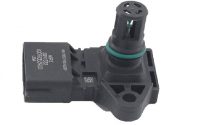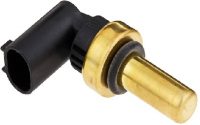What is NTC Thermistor : Working & Its Applications
The first NTC thermistor was discovered by Michael Faraday in 1833 and he was given a report on the silver sulfide semiconducting behavior. He observed that the silver sulfide resistance is decreased dramatically once the temperature increased. Because initial thermistors were hard to create & the technology applications were partial and commercial thermistors production did not start until the 1930s.
So, a commercially viable thermistor namely “Duracell” was launched in 1930 by Samuel Ruben. After that, the investigation of NTC thermistors attains major development because of the development in incessant transistor technology. So finally NTC thermistors were developed in 1960. So this article discusses on NTC thermistors, working with applications.
What is NTC Thermistor?
In an NTC thermistor, the term NTC stands for “Negative Temperature Coefficient” is an electric resistor with a negative temperature coefficient which means the resistance will be reduced once the temperature increases. These are mainly used as current-limiting devices and resistive temperature sensors. The NTC thermistor symbol is shown below according to the IEC standard.
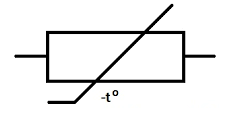
As compared to silistors or silicon temperature sensors, the temperature sensitivity coefficient of this thermistor is five times higher & ten times higher than RTDs (resistive temperature detectors). The materials used to make these Thermistors are; nickel, iron, copper, manganese, and cobalt. The temperature range of these resistors ranges from −55°C to +200 °C.
NTC Thermistor Working Principle
The working principle of the NTC thermistor is mainly dependent on the ambient temperature. Once the thermistor’s temperature enhances then its resistance will be decreased. For every 1-degree centigrade rise of temperature, 5% resistance will be decreased.
There are two factors that affect a material’s resistance to electrical flow: the number of free electrons in the material and the ease with which they can move through it. The latter is affected by the crystal structure of the material, which will have more or fewer “free-electron paths” for the current to flow through.
NTC thermistors are made from ceramics containing metal oxides, including Mn-Ni-Co oxide, Ni-Cr oxide and Cu-Ni oxide with additives. When these metals are combined with oxygen, they form bonds that limit the number of free-electron paths in the crystal structure, increasing resistance.
At higher temperatures, however, collisions between atoms cause the crystal structure to break down slightly, releasing some electrons and creating free-electron paths where they didn’t exist before. The more free-electron paths there are, the less resistance there is to electrical flow. That’s how NTC thermistors exhibit a drop in resistance as temperature increases.
NTC Thermistor Specifications:
The specifications of an NTC thermistor include the following.
- Resistance is 10K ± 1% at 25 degrees Centigrade.
- B-value is 3950 ± 1%.
- Its response time is very fast from 0.12 to 10s.
- Dissipation factor δth is approximately 7.5mW/K.
- The thermal cooling time constant is <= 20 Sec.
- Temperature ranges from -55 °C to +200 °C.
- Available terminals are two.
- Linearity is exponential.
- Its accuracy ranges from 0.05°C to 1.00°C.
- The maximum tolerance is up to ±1.5% at –40°C & 150°C.
- Its cost ranges from low to moderate.
Types of NTC thermistor
NTC thermistors are classified into three types based on their construction which is discussed below.
Bead Thermistors
Bead thermistors are constructed directly with platinum alloy lead wires molded into the ceramic body. These are protected by sealing them within the glass from damage while assembling and also to enhance their stability of measurement.
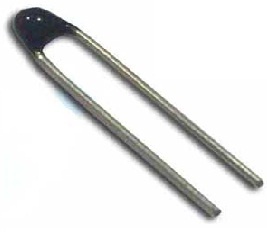
Generally, these types of thermistors are frequently used because they provide better stability, quick response times & allow their operation at maximum temperatures as compared to other types like chip and disk thermistors. The size of Bead thermistors is small and ranges from 0.075 mm to 5 mm in diameter. The most popular bead-type thermistors are glass-coated beads and miniature glass probes.
Disk & Chip Thermistors
These types of NTC thermistors are made with metalized surface contacts. These are larger in size and react slowly as compared to bead-type thermistors. These resistors have high dissipation constant due to their size. When the dissipated power of this thermistor is proportional to the square of the current, then they can handle maximum currents as compared to bead-type thermistors.
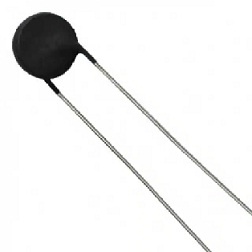
Disk type NTC thermistors are designed by pressing a mix of oxide powders into a round die at high temperatures. Chip-type thermistors are normally designed through a tape-casting method wherever a slurry of material is extended as a thick film, dried & slash into shape. The size of these thermistors ranges from 0.25mm – 25 mm in diameter.
Glass Encapsulated NTC Thermistors
Encapsulated NTC thermistors are preserved in a sealed glass bubble. These are small thermistors that avoid reading errors of resistance caused by penetration of moisture. These thermistors work efficiently in harsh environmental conditions & extreme temperatures. The temperature used by these thermistors is above 150 °C. Thermistor encapsulation within a glass enhances its stability and also protects it from the surroundings. The typical sizes of these thermostats range from 0.4 -10 mm in diameter.
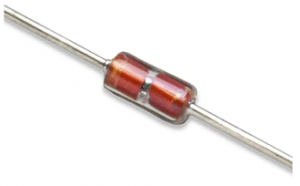
NTC Thermistor Circuit Diagram
The circuit diagram of the temperature sensor is shown below. This circuit is mainly designed to control an automatic fan with an NTC thermistor. The function of this circuit is when the temperature increases then the fan will be automatically turned ON.
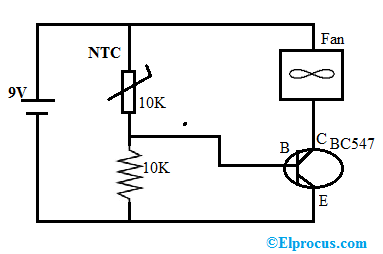
The required components to make this automatic fan controller circuit include a 10K NTC thermistor, 10K resistor, 9V battery, fan, and BC547 transistor.
The connection of this circuit can be made as per the circuit given above. In this circuit, a 10kΩ NTC thermistor is connected through a 10kΩ Resistor to make a voltage divider circuit. The resistance of this thermistor will be increased once the temperature reduces & its resistance will be reduced once the temperature increases.
The resistance of the thermistor at room temperature is 10kohms. Here the Fan in the circuit is simply connected through the BC547 transistor. Once the thermistor detects temperature then its resistance will be decreased which will cause the fan to turn ON. Once the temperature is decreased then the fan will be turned OFF.
NTC Thermistor Resistance Table
The NTC thermistor resistance mainly changes based on the temperature. The specified temperature by the manufacturer of a thermistor is generally 25°C. So the following table will show the resistance values based on temperature values.
| Temperature |
Resistance |
|
0°C |
30kΩ |
|
25°C |
10kΩ |
| 35°C |
1kΩ |
| 50°C |
4kΩ |
Difference between NTC Thermistor and PTC Thermistor
The difference between NTC thermistor and PTC thermistor include the following.
|
NTC Thermistor |
PTC Thermistor |
| In NTC thermistor, the term “NTC” stands for negative temperature co-efficient. | In PTC thermistor, the term “PTC” stands for positive temperature co-efficient. |
| In this thermistor, when the temperature increases the resistance will be decreased. | In this thermistor, when the temperature increases the resistance will be increased. |
| The materials used to make NTC thermistors are; cobalt, oxides of nickel, manganese, copper, etc. | The material used to make a PTC thermistor is barium titanate. |
| These are used in the measurement & control of temperature-based applications. | These are used to protect different circuits from high temperatures. |
| These are applicable for temperature ranges from -55oC to 200oC. | These are applicable for temperature ranges from 0oC to 200oC. |
| An example is the SMD KT series NTC thermistor designed by ATC Semitec Limited. | An example is; SMD PTC thermistors designed by ATC Semitec Limited. |
Advantages
The advantages of an NTC thermistor include the following.
- They have High flexibility and sensitivity.
- It can be used as a temperature sensor to detect temperature.
- These thermistors provide high accuracy & interchangeability simultaneously.
- NTC thermistors have high reliability, accuracy, good performance, good heat resistance, small volume, etc.
- A wide range of tolerances & sizes is available.
- As compared to other temperature-sensitive resistors, NTC thermistors have a main advantage like sensitivity.
- These thermistors respond to even mild changes in temperature.
- They can precisely detect a wave that is below a single degree within the temperature.
Disadvantages
The disadvantages of NTC thermistors include the following.
- NTC thermistors are very sensitive components so they can destroy the entire appliance once overheating occurs.
- If this thermistor is damaged, then the dryer will not work at all.
- These are specially made, so replacement is not possible.
- While selecting an NTC thermistor, it is essential to verify the working point of the center temperature.
- Applications
- The applications of NTC thermistors include the following.
- The NTC (negative temperature coefficient) thermistors can be used as resistance thermometers within extremely low-temperature measurements.
- These are normally used in current digital thermostats.
- These are very helpful in monitoring the temperature of the battery while they charging.
- These thermistors are used in electronic circuits as current-limiting devices.
- These can also be used as an alternative to a fuse.
- NTC thermistor is used as temperature compensation devices.
Thus, this is brief information about the NTC thermistor – working, and its applications, Here is a question for you, what is an alternate name for a thermistor?


